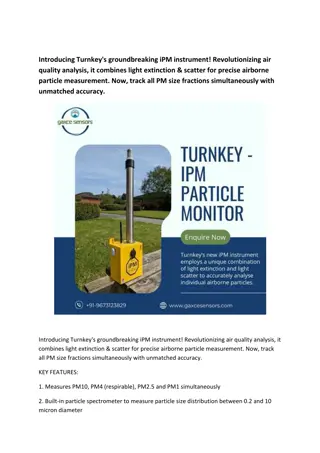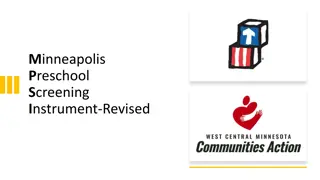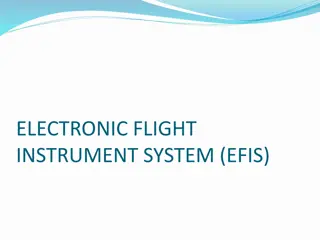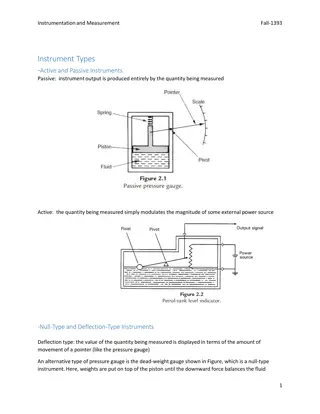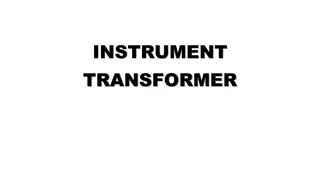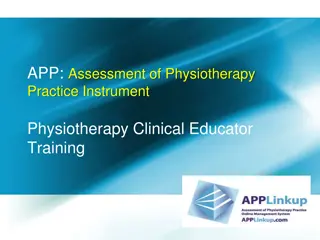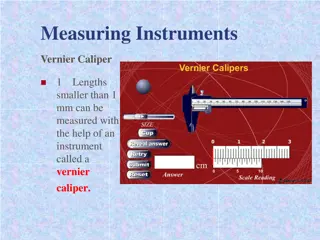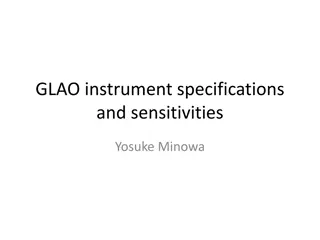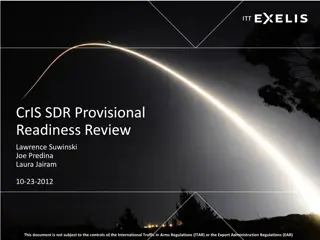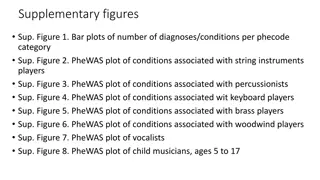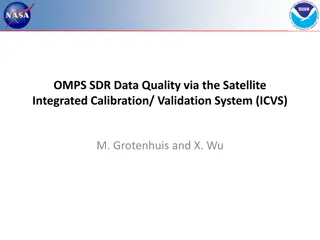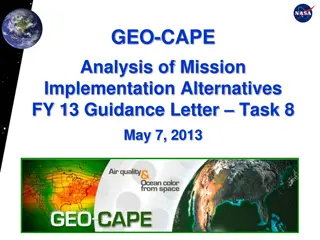Instrument human capital cybersecurity mkb bedrijven
This concise instrument helps small and medium-sized businesses in the Netherlands enhance their cybersecurity by leveraging human capital. It provides practical tips and guidance on organizing cybersecurity within the company, focusing on employees (internally) and professionals/suppliers/advisors
1 views • 59 slides
Understanding Women's Smoking Behavior: A Pilot Test of Readiness and Motivation Instrument
Conducted with 495 women smokers in public health clinics, the pilot test assessed readiness and motivation to change smoking behavior. Findings highlighted varying stages of readiness and motivation, with a focus on pregnancy enhancing the readiness to quit. The instrument designed accommodates low
2 views • 28 slides
Vi-CELL.BLU - Advanced Cell Counting Instrument
Vi-CELL.BLU is a cutting-edge cell counting instrument that offers faster analysis, increased resolution, and improved optical sensor technology for enhanced cell concentration and viability assessments. The device features a user-friendly interface, Trypan blue method for live cell detection, and a
1 views • 19 slides
Understanding Data Acquisition and Instrument Interface
In the realm of data acquisition and instrument interface, various components come together to sense physical variables, condition electrical signals, convert analog to digital data, and analyze the acquired information. This process involves transducers, signal analysis, instrument automation, and
3 views • 54 slides
European Spallation Source Neutron Instrument Project Overview
The European Spallation Source (ESS) Neutron Instrument Project aims to develop 15 world-leading neutron instruments by 2023. The project involves instrument classes, performance targets, budget considerations, and a planned schedule for instrument commencement. The NSS project scope includes reduci
4 views • 18 slides
Exploring Lunar Surface Radiation Risks and Mitigations Using Bioengineering
Lunar Explorer Instrument for space biology applications, LEIA Mission, addresses radiation health risks for crewed lunar exploration. The project aims to engineer yeast strains to study radiation sensitivity and identify genetic factors affecting cellular response. The instrument suite includes Bio
6 views • 8 slides
Introducing Turnkey's groundbreaking iPM instrument
\nIntroducing Turnkey's groundbreaking iPM instrument! Revolutionizing air quality analysis, it combines light extinction & scatter for precise airborne particle measurement. Now, track all PM size fractions simultaneously with unmatched accuracy. \nKEY FEATURES:\n1. Measures PM10, PM4 (respirable),
1 views • 2 slides
Understanding Classification Keys for Identifying and Sorting Things
A classification key is a tool with questions and answers, resembling a flow chart, to identify or categorize things. It helps in unlocking the identification of objects or living things. Explore examples like the Liquorice Allsorts Challenge and Minibeast Classification Key. Also, learn how to crea
1 views • 6 slides
Minneapolis Preschool Screening Instrument-Revised Guide
This guide provides comprehensive information on the Minneapolis Preschool Screening Instrument-Revised (MPSI-R). Learn how to administer the tool, calculate chronological age, identify information, and score the MPSI-R accurately. The guide covers various languages served, scoring procedures, and s
1 views • 14 slides
Basics of Fingerprinting Classification and Cataloguing
Fingerprint classification is crucial in establishing a protocol for search, filing, and comparison purposes. It provides an orderly method to transition from general to specific details. Explore the Henry Classification system and the NCIC Classification, and understand why classification is pivota
5 views • 18 slides
Understanding Electronic Flight Instrument System (EFIS)
An Electronic Flight Instrument System (EFIS) replaces traditional flight deck instruments with electronic displays like the Primary Flight Display (PFD) and Multi-Function Display (MFD). EFIS enhances situational awareness for pilots by consolidating critical flight data in a single, easy-to-read i
0 views • 12 slides
Understanding ROC Curves in Multiclass Classification
ROC curves are extended to multiclass classification to evaluate the performance of models in scenarios such as binary, multiclass, and multilabel classifications. Different metrics such as True Positive Rate (TPR), False Positive Rate (FPR), macro, weighted, and micro averages are used to analyze t
3 views • 8 slides
Understanding Instruments in Instrumentation and Measurement
Passive and active instruments play key roles in measurement, with null-type and deflection-type instruments providing different ways to display values. Analogue and digital instruments offer varying outputs, while indicating instruments and those with signal outputs serve different purposes. Smart
2 views • 12 slides
Understanding Classification in Data Analysis
Classification is a key form of data analysis that involves building models to categorize data into specific classes. This process, which includes learning and prediction steps, is crucial for tasks like fraud detection, marketing, and medical diagnosis. Classification helps in making informed decis
2 views • 72 slides
AI Projects at WIPO: Text Classification Innovations
WIPO is applying artificial intelligence to enhance text classification in international patent and trademark systems. The projects involve automatic text categorization in the International Patent Classification and Nice classification for trademarks using neural networks. Challenges such as the av
2 views • 10 slides
Understanding Instrument Transformers in Electrical Systems
In electrical power systems, instrument transformers play a crucial role by stepping down high currents and voltages to levels suitable for measurement using instruments like current transformers (C.T.) and potential transformers (P.T.). These transformers offer numerous advantages such as independe
1 views • 29 slides
Assessment of Physiotherapy Practice Instrument Overview
This content provides an in-depth look at the Assessment of Physiotherapy Practice (APP) instrument used for evaluating student performance on clinical placements in Australian Physiotherapy Programs. It covers the development, components, and usage of the standardized instrument, along with its rol
0 views • 37 slides
Impact Evaluation of Statutory Instrument 64 of 2016 on Consumer Prices in Zimbabwe
Statutory Instrument 64 of 2016 in Zimbabwe regulates the importation of various products to promote local production. The legislation does not ban imports but requires licensing for bulk importers. The consumer prices of certain goods increased post-implementation, influenced by factors beyond SI 6
0 views • 14 slides
Understanding Vernier Caliper: Precise Measurement Instrument
Vernier caliper is a precise measuring instrument used for measurements smaller than 1 mm with an accuracy up to 0.01 cm. It consists of two pairs of jaws for measuring linear dimensions, external, and internal diameters. The steps to measure with a vernier caliper involve aligning the main scale an
0 views • 35 slides
Understanding Taxonomy and Scientific Classification
Explore the world of taxonomy and scientific classification, from the discipline of classifying organisms to assigning scientific names using binomial nomenclature. Learn the importance of italicizing scientific names, distinguish between species, and understand Linnaeus's system of classification.
0 views • 19 slides
Overview of Fingerprint Classification and Cataloguing Methods
Explore the basics of fingerprint classification, including Henry Classification and NCIC Classification systems. Learn about the importance of classification in establishing protocols for searching and comparison. Discover the components of Henry Classification, such as primary, secondary, sub-seco
1 views • 21 slides
Understanding BioStatistics: Classification of Data and Tabulation
BioStatistics involves the classification of data into groups based on common characteristics, allowing for analysis and inference. Classification organizes data into sequences, while tabulation systematically arranges data for easy comparison and analysis. This process helps simplify complex data,
0 views • 12 slides
Overview of GLAO Instrument Specifications and Sensitivities
The content discusses the GLAO instrument specifications and sensitivities as presented by Yosuke Minowa. It covers simulated instruments as of 2013, including wide-field NIR imaging, BB imaging, NB imaging, MOS spectroscopy, and more. A new instrument plan for a multi-object fiber IFU spectrograph
1 views • 13 slides
Introduction to Decision Tree Classification Techniques
Decision tree learning is a fundamental classification method involving a 3-step process: model construction, evaluation, and use. This method uses a flow-chart-like tree structure to classify instances based on attribute tests and outcomes to determine class labels. Various classification methods,
5 views • 20 slides
Understanding Text Classification in Information Retrieval
This content delves into the concept of text classification in information retrieval, focusing on training classifiers to categorize documents into predefined classes. It discusses the formal definitions, training processes, application testing, topic classification, and provides examples of text cl
0 views • 57 slides
Understanding Taxonomy and Classification in Biology
Scientists use classification to group organisms logically, making it easier to study life's diversity. Taxonomy assigns universally accepted names to organisms using binomial nomenclature. Carolus Linnaeus developed this system, organizing organisms into species, genus, family, order, class, phylum
0 views • 11 slides
Exelis Engineering Support for CrIS Post-Launch Operations
Exelis played a key role in providing support for the CrIS satellite instrument post-launch operations. The support included activities such as early orbit instrument checkout, calibration table uploads, and developing new algorithms for better data processing. Exelis also assisted in updating Engin
0 views • 56 slides
Mineral and Energy Resources Classification and Valuation in National Accounts Balance Sheets
The presentation discusses the classification and valuation of mineral and energy resources in national accounts balance sheets, focusing on the alignment between the System of Environmental-Economic Accounting (SEEA) and the System of National Accounts (SNA) frameworks. It highlights the need for a
0 views • 17 slides
Event Classification in Sand with Deep Learning: DUNE-Italia Collaboration
Alessandro Ruggeri presents the collaboration between DUNE-Italia and Nu@FNAL Bologna group on event classification in sand using deep learning. The project involves applying machine learning to digitized STT data for event classification, with a focus on CNNs and processing workflows to extract pri
0 views • 11 slides
Analysis of Health Conditions Associated with Music Instrument Players
This analysis includes bar plots and PheWAS plots showcasing the number of diagnoses/conditions per Phecode category and conditions associated with various music instrument players such as string, percussionists, keyboard, brass, woodwind, vocalists, and child musicians aged 5 to 17. The plots revea
0 views • 9 slides
Hierarchical Semi-Supervised Classification with Incomplete Class Hierarchies
This research explores the challenges and solutions in semi-supervised entity classification within incomplete class hierarchies. It addresses issues related to food, animals, vegetables, mammals, reptiles, and fruits, presenting an optimized divide-and-conquer strategy. The goal is to achieve semi-
0 views • 18 slides
Understanding Classification in Data Mining
Classification in data mining involves assigning objects to predefined classes based on a training dataset with known class memberships. It is a supervised learning task where a model is learned to map attribute sets to class labels for accurate classification of unseen data. The process involves tr
0 views • 26 slides
Understanding Instrument Air Quality Standards in Industrial Applications
TESCORP, based in Tulsa, Oklahoma, specializes in distributing, fabricating, and servicing compression systems globally. Instrument air quality standards are crucial for pneumatic instruments in various industries. ANSI/ISA 7.0.0.1996 sets the standard for instrument air quality, focusing on pressur
0 views • 17 slides
Monitoring Data Quality via Satellite Integrated Calibration/Validation System (ICVS)
Explore the OMPS ICVS, a system designed to monitor and evaluate the performance of OMPS and its SDR, aiding in anomaly investigation and resolution. The ICVS team collaborates to establish best practices for performance evaluation and visualization of instrument status. Discover how high-level inst
0 views • 13 slides
Workshop on Developing a National Instrument on Internal Displacement
This workshop aims to equip participants with the technical skills needed to develop a national instrument on internal displacement, focusing on prevention, protection, and durable solutions. Objectives include defining rationale, identifying instrument type, and planning a consultative process. Var
0 views • 7 slides
Overview of Hutchinson and Takhtajan's Plant Classification System
Hutchinson and Takhtajan, as presented by Dr. R. P. Patil, Professor & Head of the Department of Botany at Deogiri College, Aurangabad, have contributed significantly to the field of plant classification. John Hutchinson, a renowned British botanist, introduced a classification system based on princ
0 views • 20 slides
Understanding the EPA's Ozone Advance Program and Clean Air Act
The content covers key information about the EPA's Ozone Advance Program, including the basics of ozone, the Clean Air Act requirements, designation vs. classification, classification deadlines, and marginal classification requirements. It explains the formation of ozone, the importance of reducing
0 views • 40 slides
Deep Learning for Low-Resolution Hyperspectral Satellite Image Classification
Dr. E. S. Gopi and Dr. S. Deivalakshmi propose a project at the Indian Institute of Remote Sensing to use Generative Adversarial Networks (GAN) for converting low-resolution hyperspectral images into high-resolution ones and developing a classifier for pixel-wise classification. The aim is to achiev
0 views • 25 slides
Overview of GEO-CAPE Mission Implementation Analysis
The GEO-CAPE mission implementation analysis for FY 13 involved assessing instrument and mission risks, focusing on the impact of the TEMPO instrument on atmospheric science capabilities. Recommendations were made to update the instrument suite to align with evolving requirements. Risks were categor
0 views • 5 slides
Robust High-Dimensional Classification Approaches for Limited Data Challenges
In the realm of high-dimensional classification with scarce positive examples, challenges like imbalanced data distribution and limited data availability can hinder traditional classification methods. This study explores innovative strategies such as robust covariances and smoothed kernel distributi
0 views • 10 slides






